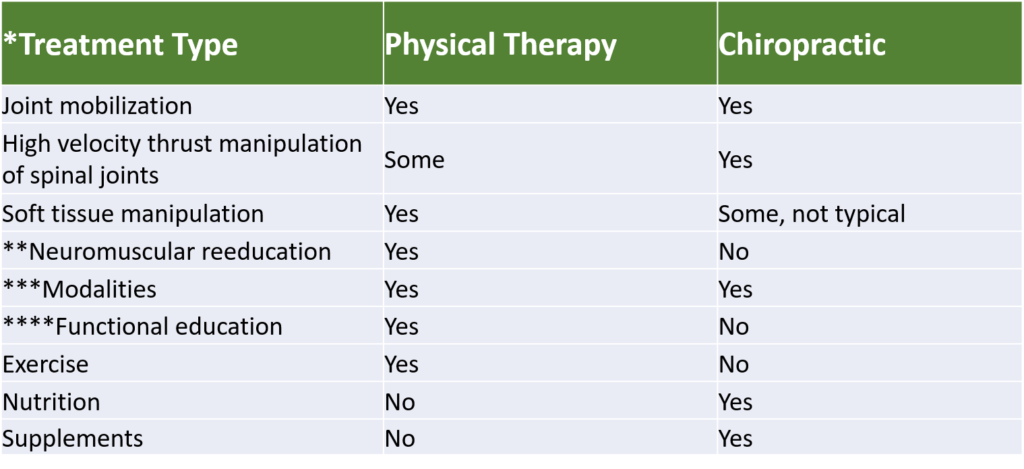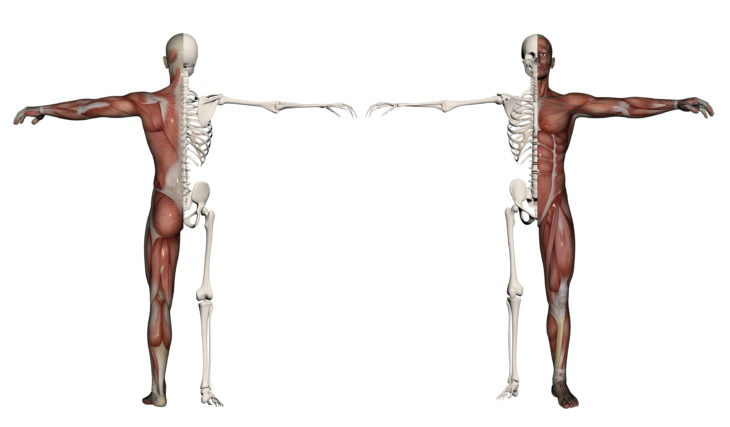I’m often asked, what is the difference between chiropractic and physical therapy?
When you have back pain, who do you think of to go to first, a chiropractor or physical therapist? When I asked 28-year-old Marta why she came to see me, she said she’d been seeing a chiropractor for the past year without any relief. Her first impression was that chiropractors take care of back pain. It wasn’t until she went to see an MD who suggested she go to physical therapy that she realized PT’s can also help with back pain. This is obviously an educational or marketing issue that our profession needs to work on.
Marta had a two-year bout of upper back and neck pain. Through an initial evaluation, I found that she had poor core and scapular (upper back) stability with a particular weakness in her upper abdominal muscles. Marta sits the majority of the day while at work. After four months of specific exercises to strengthen her core and improve her posture, and hands-on (manual) therapy, Marta is essentially pain-free. She is now slowly returning to a higher intensity exercise routine.
So, what did we do that was different than chiropractic? Marta received exercises and education how to take care of her body throughout the day.
What did we do that was similar to chiropractic? Marta received hands-on or manual therapies from both practitioners. However, her chiropractor only worked directly on the spine while in PT we worked on her spine and soft tissues such as her diaphragm, abdominals, and fascia.
So while both chiropractors and physical therapists treat this condition, the difference is in the healing approach.
The Main Difference: Physical Therapists are Movement Experts
According to the American Physical Therapy Association (APTA), Physical therapists are movement experts who optimize quality of life through prescribed exercise, hands-on care, and patient education. After making a diagnosis, physical therapists create personalized treatment plans that help their patients improve mobility, manage pain and other chronic conditions, recover from injury, and prevent future injury and chronic disease. Physical therapists empower people to be active participants in their own treatment, and they work collaboratively with other health professionals to ensure patients receive comprehensive care.
According to the American Chiropractic Association (ACA), “Chiropractic is a health care profession that focuses on disorders of the musculoskeletal system and the nervous system, and the effects of these disorders on general health. Chiropractors or chiropractic physicians practice a hands-on, drug-free approach to health care and are also trained to recommend therapeutic and rehabilitative exercises, as well as to provide nutritional, dietary and lifestyle counseling.” The ACA homepage even mentions back care: “Chiropractic services are used most often to treat neuromusculoskeletal complaints, including but not limited to back pain, neck pain, pain in the joints of the arms or legs, and headaches.”
Some chiropractors claim to do physical therapy, but I advise you to pay close attention to how they define physical therapy. My understanding is that chiropractors are taught “physical therapy” at a weekend seminar teaching them basic electrical modalities, not movement or function. Those in my profession often wonder how the term “physical therapy” can be used in this manner.
So which is right for you?
Now, like any profession, no two chiropractors treat alike nor will two physical therapists treat alike. As both professions use hands-on therapy to manipulate bones, joints, and soft tissue – it will be up to you to determine who you will respond best to by evaluating the practitioner’s style of hands-on therapies.
 *The above table is a generalization, not an absolute
*The above table is a generalization, not an absolute
**Neuromuscular reeducation – exercises specifically designed to integrate the nervous and musculoskeletal system to function optimally.
***Modalities – machines to promote healing via electricity, laser, ultrasound, shockwave, etc
****Functional education – the education of how to do everyday functional activities such as posture, sit to stand, positioning for sitting, standing, sleeping, etc.
There is no reason a person can’t see both a chiropractor and physical therapist, as each type of practitioner tends to do different things. In fact, I often send some of my patients to certain chiropractors because they offer something different than I do as part of my personalized approach to physical therapy.
If you are still unsure of where to begin your healing journey, please call the practitioner’s office and ask questions, review their websites and read reviews to get a better understanding of the practitioner’s approach.
Regardless, If you are seeing a practitioner and aren’t seeing some improvement after 4-6 weeks, it may be time to look elsewhere for answers.







I really like that you touched on how you should be seeing some good results in around 5 weeks. My mom is getting older and it’s harder for her to stay active anymore. We need to find a good physical therapist that can help her stay on the right path so that she remains happy and healthy.
My back has been having issues, and I’m not sure what to do about it. I think it might be due to my posture. It might be a good idea for me to work with a professional to see if they can help me out with this.